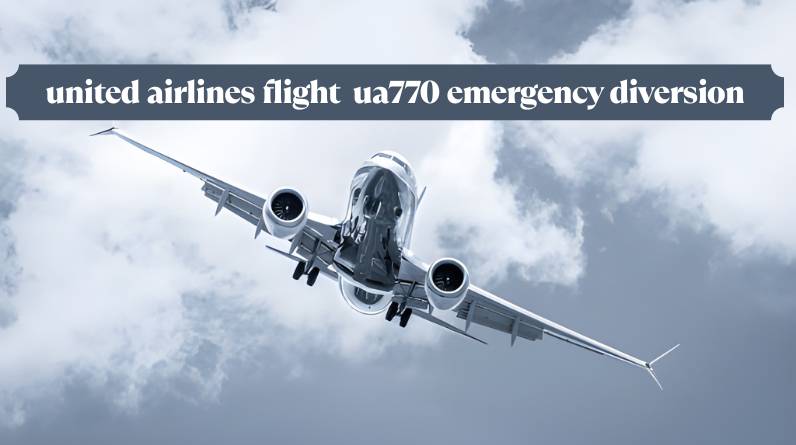
Understanding the United Airlines Flight UA770 Emergency Diversion: A Critical Analysis
On July 28, 2025, United Airlines Flight UA770 became a focal point in aviation safety discussions when the aircraft executed an emergency diversion from its planned San Francisco to Chicago route, landing instead at Denver International Airport. While emergency diversions occur more frequently than passengers realize, this particular incident offers valuable insights into modern aviation safety protocols, crew decision-making under pressure, and the delicate balance between operational efficiency and passenger protection.
This comprehensive analysis examines not just what happened during Flight UA770’s emergency diversion, but why these protocols exist, how they protect passengers, and what travelers should understand about aviation safety in an era of increasingly complex aircraft systems.
The Incident Timeline: From Routine Flight to Emergency Response
Departure and Initial Flight Phase
United Airlines Flight UA770 departed San Francisco International Airport at approximately 7:30 AM on a typical summer morning. The Boeing aircraft carried a full complement of passengers and crew, all expecting an uneventful cross-country journey to Chicago O’Hare International Airport. The flight plan called for a standard route across the Rocky Mountains, with an estimated flight time of just under four hours.
For the first 90 minutes, the flight proceeded normally. Passengers settled into their seats, flight attendants completed beverage service, and the aircraft climbed to cruising altitude over the mountainous terrain of the western United States.
The Critical Moment: System Warning Detection
Approximately 90 minutes into the flight, the cockpit crew detected unusual indicators related to the aircraft’s hydraulic system. This wasn’t a complete system failure, but rather warning signals that indicated potential anomalies requiring immediate assessment. In modern aviation, even preliminary warnings trigger carefully choreographed response protocols designed to prevent small issues from escalating into serious emergencies.
The captain made the decision to declare an emergency and divert to Denver International Airport, the nearest major facility equipped with comprehensive emergency response capabilities and United Airlines maintenance infrastructure.
Understanding Hydraulic Systems: Why This Warning Demanded Immediate Action
The Critical Role of Hydraulic Systems in Aircraft Operations
To understand why the crew’s response was both appropriate and necessary, it’s essential to grasp what hydraulic systems control in modern commercial aircraft. These systems are far more than auxiliary components; they represent the primary control mechanism for several flight-critical functions:
- Flight Control Surfaces: Ailerons, elevators, and rudders that enable pilots to maneuver the aircraft
- Landing Gear Operation: Extension and retraction mechanisms essential for safe takeoffs and landings
- Braking Systems: Primary and backup braking mechanisms used during landing and ground operations
- Flap and Slat Control: Systems that modify wing configuration for different flight phases
Why Crews Don’t Wait for Confirmation of Failure
Modern aviation safety philosophy operates on a principle of conservative risk management. Flight crews are trained to respond to warning indicators before actual system failures occur. This proactive approach has contributed to commercial aviation’s remarkable safety record, where the accident rate has declined to approximately 0.27 accidents per million flights globally.
In the case of hydraulic system warnings, waiting to confirm an actual failure could mean losing critical control authority at the worst possible moment, such as during final approach or landing. The crew of Flight UA770 followed established protocols by treating the warning as a genuine threat requiring immediate mitigation.
Crew Performance: Professionalism Under Pressure
Communication and Passenger Management
One of the most remarkable aspects of the Flight UA770 incident was how the crew managed passenger anxiety while executing complex emergency procedures. According to passenger testimonials shared on social media, the captain provided regular updates through the public address system, explaining the situation in clear, non-technical language that balanced honesty with reassurance.
Flight attendants moved methodically through the cabin, checking seat belt compliance, securing loose items, and providing personalized attention to elderly passengers and families with children. This dual focus on technical emergency response and passenger care reflects thousands of hours of training that commercial flight crews undergo.
Coordination with Air Traffic Control and Ground Services
Behind the scenes, the crew was simultaneously coordinating with multiple external parties. Air traffic control immediately cleared airspace for the diverting aircraft, providing priority routing and approach clearance to Denver. Ground emergency services at Denver International Airport were placed on standby, with fire trucks and emergency medical personnel positioned near the designated arrival runway.
This coordination happened within minutes, demonstrating the well-rehearsed nature of emergency response protocols across the aviation industry.
The Passenger Experience: Anxiety, Information, and Relief
Emotional Journey Through an Unexpected Event
For the passengers aboard Flight UA770, the experience represented a spectrum of emotions compressed into a relatively short timeframe. Initial announcements about the diversion triggered predictable anxiety, as passengers contemplated worst-case scenarios and worried about the implications of an “emergency” landing.
However, the crew’s transparent communication strategy helped mitigate panic. By explaining that the diversion was precautionary rather than reactive to an actual failure, the captain provided context that helped passengers understand they were experiencing aviation safety working as designed, not a crisis spiraling out of control.
Social Media as Real-Time Documentation
The incident also highlighted how social media has transformed passenger experiences during aviation events. Multiple passengers documented their experience on platforms like X (formerly Twitter), with one passenger posting: “Shoutout to the UA770 crew. They kept us informed and calm. Unexpected landing in Denver but glad to be safe.”
These real-time accounts provided valuable transparency and served as informal testimonials to the crew’s professional performance during the emergency.
United Airlines’ Response: Corporate Accountability and Passenger Care
Immediate Passenger Accommodation
Following the safe landing at Denver International Airport, United Airlines implemented its passenger care protocols, which included:
- Meal vouchers for all affected passengers
- Rebooking on the next available flights to Chicago
- Hotel accommodations for passengers whose connections were significantly disrupted
- Direct customer service assistance for passengers with special circumstances
Aircraft Inspection and Maintenance Response
United Airlines grounded the aircraft immediately upon landing and initiated a comprehensive maintenance inspection focused on the hydraulic system that triggered the warning. This inspection would include detailed examination of hydraulic fluid levels, pressure readings, pump functionality, and electronic sensor calibration to determine whether the warning indicated an actual developing problem or a sensor malfunction.
The aircraft would not return to service until maintenance personnel could confirm the system’s complete integrity and identify the root cause of the warning indicators.
Regulatory Oversight: The FAA’s Role in Emergency Investigations

Standard Investigation Procedures
The Federal Aviation Administration confirmed it would review the Flight UA770 incident as part of standard procedures following any declared in-flight emergency. These investigations serve multiple purposes:
| Investigation Component | Purpose | Expected Outcome |
|---|---|---|
| Crew Decision Review | Assess adherence to protocols | Validation of emergency response procedures |
| Maintenance History Analysis | Identify potential contributing factors | Recommendations for preventive measures |
| System Warning Evaluation | Determine accuracy of warning indicators | Potential sensor improvements or recalibration |
| Communication Assessment | Review crew-ATC coordination | Best practice documentation for training |
Transparency and Industry-Wide Learning
FAA investigations aren’t punitive exercises designed to assign blame, but rather learning opportunities that strengthen aviation safety across the entire industry. Findings from incidents like Flight UA770’s diversion are shared through safety bulletins, incorporated into training programs, and used to refine maintenance protocols.
The Broader Context: Emergency Diversions in Modern Aviation
How Common Are Emergency Diversions?
While emergency diversions capture public attention and passenger anxiety, they represent a small but regular component of commercial aviation operations. According to aviation industry data, major airlines experience diversions for various reasons on a daily basis, including:
- Medical emergencies requiring immediate passenger care
- Weather conditions exceeding safe operating parameters
- Mechanical warnings or actual system malfunctions
- Disruptive passenger behavior requiring law enforcement intervention
- Airport closures or emergency declarations at intended destinations
The vast majority of these diversions, like Flight UA770, conclude safely without incident, demonstrating that these protocols work effectively to protect passenger safety.
Economic and Operational Impacts
For airlines, diversions represent significant operational and financial challenges. A single diversion can cost an airline between $10,000 and $200,000, depending on factors such as aircraft repositioning, passenger accommodations, crew scheduling disruptions, and maintenance requirements.
Despite these costs, airlines consistently prioritize safety over financial considerations. The decision to divert Flight UA770 likely cost United Airlines tens of thousands of dollars, but that expense pales in comparison to the value of passenger safety and the potential consequences of continuing a flight with questionable system integrity.
Lessons for Passengers: What Travelers Should Understand
Emergency Diversions Reflect Safety, Not Danger
Perhaps the most important lesson from the Flight UA770 incident is that emergency diversions should be viewed as evidence of aviation safety working properly, not as near-miss catastrophes. When crews divert aircraft based on warning indicators, they’re implementing conservative safety protocols designed to ensure that potential problems never evolve into actual emergencies.
Trust the System and the Crew
Commercial aviation’s safety record is unparalleled among transportation modes. Passengers aboard flights like UA770 should understand that:
- Flight crews undergo thousands of hours of training, including extensive emergency scenario simulation
- Modern aircraft have multiple redundant systems for critical functions
- Regulatory oversight ensures airlines maintain rigorous safety standards
- Emergency response protocols are continuously refined based on incident learnings
Conclusion: Flight UA770 as a Case Study in Aviation Safety Excellence
The United Airlines Flight UA770 emergency diversion on July 28, 2025, stands as a testament to modern aviation safety’s effectiveness. From the initial detection of hydraulic system warnings to the safe landing in Denver, every phase of the incident demonstrated the value of conservative safety protocols, professional crew performance, and robust emergency response coordination.
For the passengers aboard Flight UA770, the experience was undoubtedly stressful and disruptive. However, they were also witnesses to aviation safety working exactly as designed—with trained professionals making prudent decisions, transparent communication reducing anxiety, and a system-wide commitment to protecting human life above all other considerations.
As investigations continue and lessons are incorporated into training and procedures, incidents like Flight UA770’s diversion will continue to strengthen commercial aviation’s already impressive safety record, ensuring that flying remains the safest form of long-distance transportation available to travelers worldwide.









